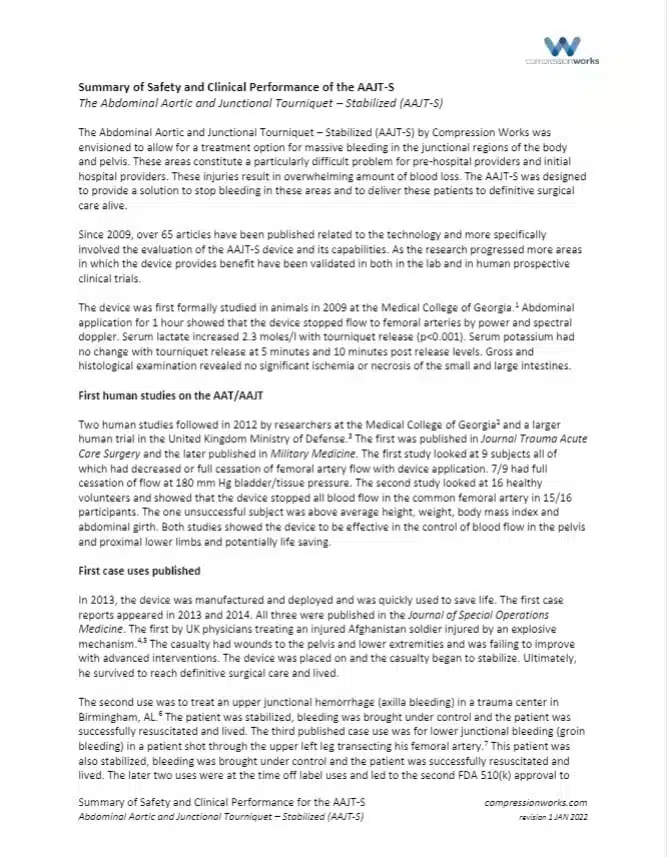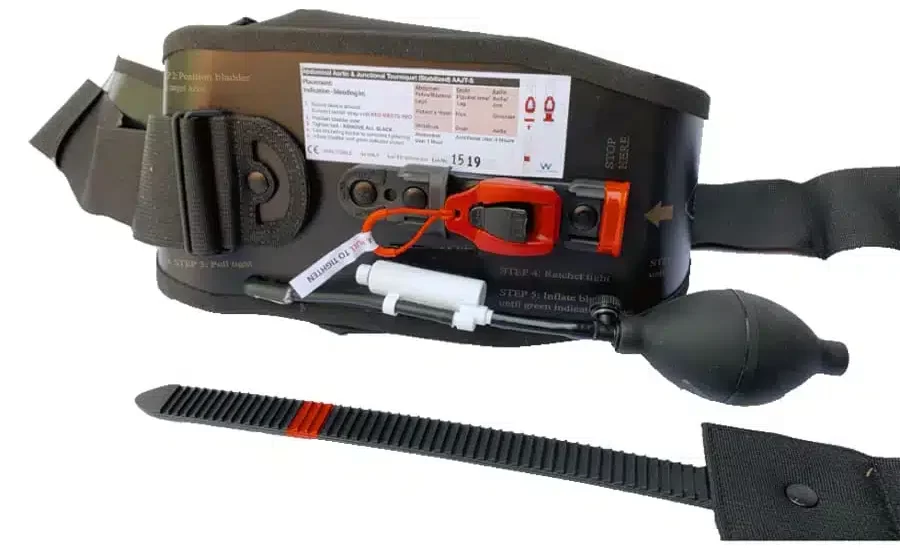Summary of Safety and Clinical Performance of the AAJT-S
The Abdominal Aortic and Junctional Tourniquet – Stabilized (AAJT–S)
Note: This article was taken from compressionworks.com
Non-compressible hemorrhages are the cause of death for tens of thousands annually. Many injuries with difficult-to-manage bleeding situations in the abdomen, axilla, pelvis and inguinal areas require immediate care by first responders, paramedics, EMS professionals, emergency physicians, police officers and firefighters to help stabilize accident victims. The ability to control difficult to manage hemorrhages quickly and easily is imperative for patient survival until they can reach definitive care.
The Abdominal Aortic and Junctional Tourniquet – Stabilized (AAJT–S) by Compression Works was envisioned to allow for a treatment option for massive bleeding in the junctional regions of the body and pelvis. These areas constitute a particularly difficult problem for pre–hospital providers and initial hospital providers. These injuries result in an overwhelming amount of blood loss. The AAJT–S was designed to provide a solution to stop bleeding in these areas and to deliver these patients to definitive surgical care alive.
Since 2009, over 70 articles have been published related to the technology and more specifically involved the evaluation of the AAJT–S device and its capabilities. As the research progressed, more areas in which the device provides benefit have been validated in both the lab and human prospective clinical trials.
The device was first formally studied in animals in 2009 at the Medical College of Georgia.¹ Abdominal application for 1 hour showed that the device stopped flow to femoral arteries by power and spectral doppler. Serum lactate increased 2.3 moles/l with tourniquet release (p<0.001). Serum potassium had no change with tourniquet release at 5 minutes and 10 minutes post-release levels. Gross and histological examination revealed no significant ischemia or necrosis of the small and large intestines.
First human studies on the AAT/AAJT
Two human studies followed in 2012 by researchers at the Medical College of Georgia² and a larger human trial in the United Kingdom Ministry of Defense.³ The first was published in Journal Trauma Acute Care Surgery and the later published in Military Medicine. The first study looked at 9 subjects all of which had decreased or full cessation of femoral artery flow with device application. 7/9 had full cessation of flow at 180 mm Hg bladder/tissue pressure. The second study looked at 16 healthy volunteers and showed that the device stopped all blood flow in the common femoral artery in 15/16 participants. The one unsuccessful subject was above average height, weight, body mass index and abdominal girth. Both studies showed the device to be effective in the control of blood flow in the pelvis and proximal lower limbs and potentially life-saving.
First case uses published
In 2013, the device was manufactured and deployed and was quickly used to save life. The first case reports appeared in 2013 and 2014. All three were published in the Journal of Special Operations Medicine. The first by UK physicians treating an injured Afghanistan soldier injured by an explosive mechanism.4,5 The casualty had wounds to the pelvis and lower extremities and was failing to improve with advanced interventions. The device was placed on and the casualty began to stabilize. Ultimately, he survived to reach definitive surgical care and lived.
To continue reading, download the complete summary.

The AAJT-S: Multi-Functional Life-Saving Device
- Battlefield tested
- FDA cleared for four distinct indications (axilla, inguinal, abdominal, pelvic)
- Scientifically proven in more than 70 publications
- Documented lives saved
- Only device approved for aortic compression
- Proven equivalent to Zone-3 REBOA in multiple scientific studies
- Quick and easy application
- Stays secure during patient transport
To learn more about the AAJT-S™ by Compression Works, call 888-891-1200 or email us to be connected to your local sales representative.
MED Alliance Group is a medical device distributor that has been meeting the needs of our clinical customers and manufacturing partners since 1998. Dedicated to meeting the needs of its clinical customers and manufacturing partners, MED Alliance offers cost-effective, customized sales, logistics, and distribution solutions for products found in anesthesia/respiratory, blood/transfusion therapy, EMS/emergency room, interventional radiology/cath lab, iv/vascular, NICU/PICU and pharmacy.
Please follow us on LinkedIn, Facebook and Twitter for MED Alliance product updates.
References
- Greenfield, E.m., et al. “Safety and Efficacy of a Novel Abdominal Aortic Tourniquet Device for the Control of Pelvic and Lower Extremity Hemorrhage.” Annals of Emergency Medicine, vol. 54, no. 3, 2009, doi:10.1016/j.annemergmed.2009.06.230.
- Lyon, M., et al. “Use of a novel abdominal aortic tourniquet to reduce or eliminate flow in the common femoral artery in human subjects.” J Trauma Acute Care Surg 2012; 73(2 Suppl) S103-2.
- Taylor, David M., et al. “The Evaluation of an Abdominal Aortic Tourniquet for the Control of Pelvic and Lower Limb Hemorrhage.” Military Medicine, vol. 178, no. 11, 2013, pp. 1196–1201.
- “Abdominal Aortic Tourniquet use in Afghanistan” Journal of Special Operations Medicine, Vol 13, Edition 2, Summer 2013, pp 1-2.
- Croushorn, J and Calloway, D, “Abdominal Aortic Tourniquet use in Afghanistan” Journal of Special Operations Medicine, Vol 13, Edition 2, Summer 2013, p 3.






